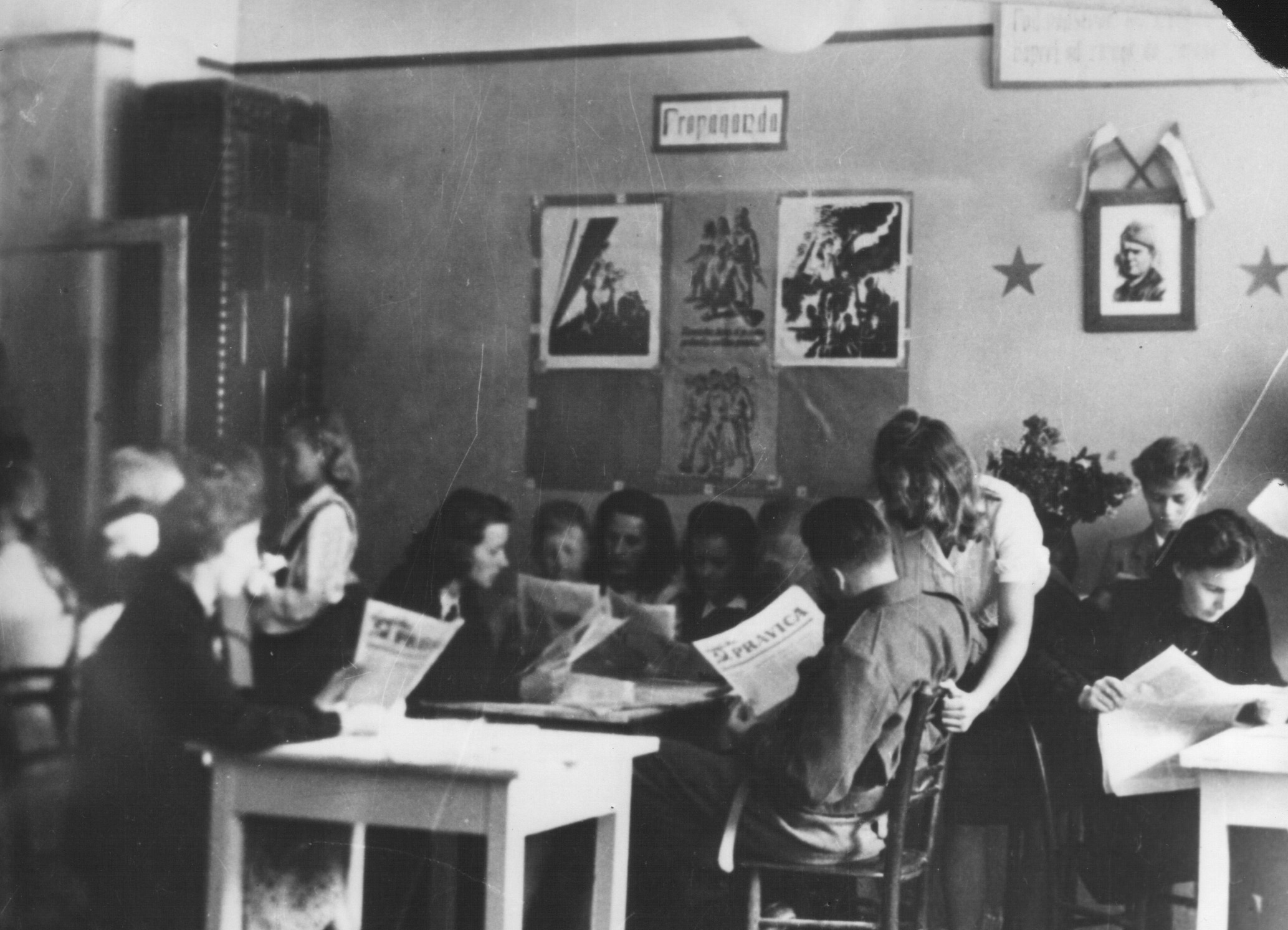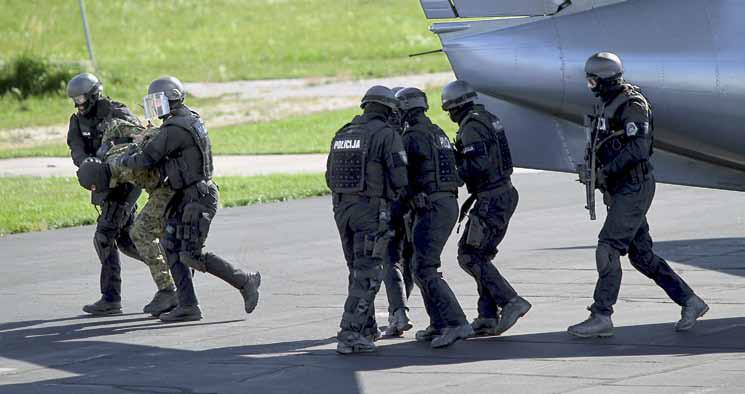|
Black Panther (symbol)
The black panther ( sl, črni panter), also known as the Carantanian panther () after the Medieval principality of Carantania, is a Carinthian historical symbol, which represents a stylized heraldic panther. As a heraldic symbol, it appeared on the coat of arms of the Carinthian Duke Herman II as well as of the Styrian Margrave Ottokar III. In this region it was most frequently imaged on various monuments and tombstones. The symbol can still be found in the coat of arms of the Austrian state of Styria, although the colours have changed. The symbol is also widely used within structures of the Slovenian security forces; namely by the Slovenian Armed Forces and the Slovenian Police. Since 1991, there have been several proposals to replace the Slovenian coat of arms with the black panther. Origin The origins of the symbol are unclear. According to the archaeologist and historian Andrej Pleterski, it appears for the first time in the coat of arms of the Sponheim family from Cari ... [...More Info...] [...Related Items...] OR: [Wikipedia] [Google] [Baidu] |
Jožko Šavli
Jožko Šavli (March 22, 1943March 11, 2011) was a Slovene author, self-declared historian and high school teacher in economic sciences from Italy. Šavli was born in Tolmin, then part of the Kingdom of Italy (now in Slovenia). He obtained a degree in Business Management at the University of Ljubljana in 1967. Then he continued his studies at the Vienna School of International Trade ("Hochschule für Welthandel"), where in 1975 he obtained a doctorate in social and economic sciences with a thesis on the economic structure and regional economic development in the district of Horn in Lower Austria. Josef Savli, ''Wirtschaftsstruktur und regionale Wirtschaftsentwicklung im polit ... [...More Info...] [...Related Items...] OR: [Wikipedia] [Google] [Baidu] |
Delo (newspaper)
''Delo'' ( en, Labour) is a national daily newspaper in Slovenia. For more than 60 years, ''Delo'' has been involved in active co-creation of the Slovenian public space. It covers politics, economics, sports, culture and social events in Slovene. In addition to Slovenia, the paper is available in several Croatian cities and in Belgrade, Serbia. It is based in Ljubljana. History ''Delo'' was first published on 1 May 1959 when the newspapers '' Ljudska pravica'' ("The People's Right"), which was published since 1934, and '' Slovenski poročevalec'' ("The Slovene Reporter"), established in 1938, both the newspapers of the Communist Party of Slovenia, merged. Among the chief editors were Dušan Benko, Darijan Košir, Peter Jančič, and Uroš Urbas. Profile ''Delo'' is published in broadsheet format by media house Delo which also owns newspaper '' Slovenske novice''. It offers content in print and also on web, mobile and tablet platforms. It publishes a mixture of different media, ... [...More Info...] [...Related Items...] OR: [Wikipedia] [Google] [Baidu] |
Duke's Chair
The Duke's Chair, also known as the Duke's Seat (german: Herzogstuhl, sl, vojvodski prestol or ), is a medieval stone seat dating from the ninth century and located at the Zollfeld plain near Maria Saal, north of Klagenfurt in the Austrian state of Carinthia (state), Carinthia. History The Duke's Chair, made mainly of Ancient Rome, Roman gravestones from nearby Virunum, actually consists of two stone seats, whose backrests are attached to each other. The larger seat, facing to the east, was reserved for the Dukes, the other one, slightly older and facing to the west, for the Count palatine, Counts palatine of the ''List of Counts of Görz, Meinhardiner'' dynasty. Together with the Prince's Stone, it played an important role during the installation of the Duchy of Carinthia, Dukes of Carinthia in a Ceremony that may date back to the Early Medieval principality of Carantania#The Ducal Inauguration, Carantania. The chair was first mentioned as ''sedes Karinthani ducatus'' on the occ ... [...More Info...] [...Related Items...] OR: [Wikipedia] [Google] [Baidu] |
Prince's Stone
The Prince's Stone (german: Fürstenstein, sl, knežji kamen) is the reversed base of an ancient Ionic column that played an important role in the ceremony surrounding the installation of the princes of Carantania in the Early Middle Ages. After the incorporation into the Frankish Empire, the procedure, held in Slovene, was continued as the first part of the coronation of the Dukes of Carinthia. It was followed by a mass at Maria Saal cathedral and the installation at the Duke's chair, where he swore an oath in German and received the homage of the estates. The stone The column probably originates from the nearby Roman city of Virunum, established as capital of the Noricum province under the reign of Emperor Claudius (AD 41–54). During the Middle Ages, the coat of arms of the Duchy of Carinthia was engraved on its top surface. Until 1862, when it was transferred to the ''Landhaus'' provincial assembly at Klagenfurt, it stood northwest of the '' Kaiserpfalz'' of Karnburg ... [...More Info...] [...Related Items...] OR: [Wikipedia] [Google] [Baidu] |
National Symbols Of Slovenia
The National symbols of Slovenia are the symbols used in Slovenia and abroad to represent the nation and its people. Political and ethnic symbols *The most common and recognizable of these are the National anthem of Slovenia and the Flag of Slovenia. *The Coat of arms of Slovenia, a part of the flag itself. *A leaf of a Linden or Lime tree, an important part of Slovene national heritage. Village assemblies, councils and other gatherings were traditionally held around circular tables beneath such a tree. *The stylized graphical representation of the three peaks of Mount Triglav, the central device of the current coat of arms, has functioned as a national symbol since World War II, having been the emblem of the Liberation Front and subsequent communist-era arms. *The coat of arms of Carniola or just its eagle are still considered national symbols, being the signs of one of the two historical Slavic duchies, Carniola and Carantania, but are considered historic rather than curr ... [...More Info...] [...Related Items...] OR: [Wikipedia] [Google] [Baidu] |
POP TV
Pop TV is a Slovenian generalist television channel operated by Pro Plus d.o.o., a subsidiary of Central European Media Enterprises (CME), which is in turn owned by Czech investment company PPF. News programs POP TV's current news programming consists of the main '' 24UR'' ("24Hours") News, ''24UR popoldne'' ("24Hours Afternoon"), ''24UR zvečer'' ("24Hours at Night"), ''24UR Vreme'' ("24Hours Weather") and ''Preverjeno!'' ("Confirmed!"). Within ''24UR'', the following segments are currently airing: "POP IN", "Vizita" ("Medical visit"), "24UR Inšpektor" ("24Hours Inspector") and "24UR Fokus" ("24Hours Focus"). ''24UR'' The current hosts of the show are two hosting pairs: Darja Zgonc & Edi Pucer, and Jani Muhič & Petra Krčmar. Weekdays the show is hosted by one pair and the pairs exchange each week. Weekend shows are hosted by individual hosts from each pair. The show is criticized as having a left-wing bias. It is often accused by the Slovenian right-wing party SDS to ... [...More Info...] [...Related Items...] OR: [Wikipedia] [Google] [Baidu] |
RTV Slovenija
Radiotelevizija Slovenija ( en, Radio-Television of Slovenia) – usually abbreviated to RTV Slovenija (or simply RTV within Slovenia) – is Slovenia's national public broadcasting organization. Based in Ljubljana, it has regional broadcasting centres in Koper and Maribor and correspondents around Slovenia, Europe, and the world. RTV Slovenija's national radio services operate under the name , while the television division carries the name or . The names are sometimes Anglicized as ''Radio Slovenia'' and ''TV Slovenia'', respectively. There are three national and four regional radio services, which can all be heard online as well. RTV Slovenija also finances the RTV Slovenia Symphony Orchestra and the RTV Slovenia Big Band. The legal foundation for the institution is the Radiotelevizija Slovenija Act ( sl, Zakon o Radioteleviziji Slovenija). It is the only public nonprofit broadcasting organization in Slovenia to operate both radio and television stations. The law also re ... [...More Info...] [...Related Items...] OR: [Wikipedia] [Google] [Baidu] |
Delo (Slovenia)
''Delo'' ( en, Labour) is a national daily newspaper in Slovenia. For more than 60 years, ''Delo'' has been involved in active co-creation of the Slovenian public space. It covers politics, economics, sports, culture and social events in Slovene. In addition to Slovenia, the paper is available in several Croatian cities and in Belgrade, Serbia. It is based in Ljubljana. History ''Delo'' was first published on 1 May 1959 when the newspapers '' Ljudska pravica'' ("The People's Right"), which was published since 1934, and '' Slovenski poročevalec'' ("The Slovene Reporter"), established in 1938, both the newspapers of the Communist Party of Slovenia, merged. Among the chief editors were Dušan Benko, Darijan Košir, Peter Jančič, and Uroš Urbas. Profile ''Delo'' is published in broadsheet format by media house Delo which also owns newspaper '' Slovenske novice''. It offers content in print and also on web, mobile and tablet platforms. It publishes a mixture of different medi ... [...More Info...] [...Related Items...] OR: [Wikipedia] [Google] [Baidu] |
Specialna Enota Policije
Specialna Enota Policije (SEP) ( en, Special Police Unit) is the police tactical unit of the Slovenian National Police Force. SEP is utilised for counter-terrorism and other high-risk tasks that are too dangerous or too difficult for regular police units. History The establishment of the first unit started in 1973 as a direct response to the hostage crisis at the 1972 Summer Olympics in Munich and the infiltration of the armed terrorist groups inside the Yugoslav territory in the same year. After the break-up of the former Yugoslavia, the unit continues with performing the tasks and missions it was established for. Functions * Anti-terrorist tasks. * Arrest of dangerous criminals. * VIP guarding. * Securing locations. * Co-operation with other Police units and their training. Selection and training The candidates who want to enter this special unit must be in service at least six and a half years. They also need a good rating of their work. Special knowledge like marti ... [...More Info...] [...Related Items...] OR: [Wikipedia] [Google] [Baidu] |
Carinthia (Slovenia)
Carinthia ( sl, Koroška ; german: Kärnten), also Slovene Carinthia or Slovenian Carinthia (''Slovenska Koroška''), is a traditional region in northern Slovenia. The term refers to the small southeasternmost area of the former Duchy of Carinthia, which after World War I was allocated to the State of Slovenes, Croats and Serbs according to the 1919 Treaty of Saint-Germain. It has no distinct centre, but a local centre in each of the three central river valleys among the heavily forested mountains. Since the entry of Slovenia into the European Union in May 2004, much effort has been made to re-integrate Carinthia as a cultural, tourism, and economic unit. The historic region has no official status as an administrative district within Slovenia, although the association with an informal province (''pokrajina'') is quite common. Geography The region lies in the Karawanks mountain range of the Southern Limestone Alps and comprises two spatially divided areas totalling : * the Me ... [...More Info...] [...Related Items...] OR: [Wikipedia] [Google] [Baidu] |
Ottonian
The Ottonian dynasty (german: Ottonen) was a Saxon dynasty of German monarchs (919–1024), named after three of its kings and Holy Roman Emperors named Otto, especially its first Emperor Otto I. It is also known as the Saxon dynasty after the family's origin in the German stem duchy of Saxony. The family itself is also sometimes known as the Liudolfings (), after its earliest known member Count Liudolf (d. 866) and one of its most common given names. The Ottonian rulers were successors of the Germanic king Conrad I, who was the only Germanic king to rule in East Francia after the Carolingian dynasty and before this dynasty. The Ottonians are associated with the notable military success that transformed the political situation in contemporary Western Europe: "It was the success of the Ottonians in molding the raw materials bequeathed to them into a formidable military machine that made possible the establishment of Germany as the preeminent kingdom in Europe from the tenth th ... [...More Info...] [...Related Items...] OR: [Wikipedia] [Google] [Baidu] |






